My 31-Year Old Apple Mac Started Up Fine After 15 Years in a Box
February 28, 2015
What would be "insanely great" now is a computer, tablet, etc. that is made to last a decade and software that was supported for the entire period.
I hope some of you will understand why I hang on to my original 1984 Macintosh computer. Thanks to macfaq.com, I recently discovered that my Mac model 0001 was the 21,447th made in week 32 of 1984 in Fremont, California.
My business partner and I bought three Macs (the 128K Model 0001) in August of 1984, at a horrendous cost per unit. As I recall, the initial retail price was around $2,500, which soon dropped to $2,300. This is still over $5,000 in 2014 dollars.
Early adopters will remember arduously swapping the 3.5-inch "stiffy" floppy drives to load applications and save files to disk.
Given these limitations, we soon spent another $1,000 per unit to upgrade to the 512K motherboard, and thousands more on external 800K drives, dot-matrix printers, memory upgrades and by the late 1980s, early-generation hard drives (a whopping 20 MB or 40 MB each, as I recall).
Some of these early Macs included a photo of the factory workers in front of the Fremont plant.
Though the original Mac looks outdated, the Mac manuals from 1984 are remarkably timeless: lots of white space on each page, cleanly formatted, etc. The Mac was not just a computer--it was a complete package of software (MacWrite and Microsoft Multiplan, the Excel precursor) and the manuals to guide a generation of neophytes.
What's equally remarkable is how the Mac interface is completely natural to any child using an iPhone, tablet, etc. today: the desktop, icons, pointing device and pulldown menus were all there in 1984.
What's been added to computers in the three decades since are: more processing power, more memory, a touch-screen and connections to the Web and other networks.(The Mac had a proprietary Apple networking protocol, AppleTalk.)
In rummaging through some boxes in the garage, I found my old 1984-vintage Mac and a 1995 replacement. The 1995 Mac's hard drive started spinning but couldn't boot up. The 31-year old original Mac, after sitting untouched in a box for at least 15 years, booted System 6 from an external floppy disk drive in a matter of seconds.
Wow. It made me wonder: how many electronic devices made today will boot up 31 years from now after sitting in a box for 15 years? It also made me wonder: if the original Mac can last 30+ years, why do we need to buy new PCs, etc. every few years?

Computing has already reached diminishing returns on processor speeds and additional memory. Faster processors and additional memory no longer make much of a difference except in a few settings. There is little reason to buy replacement PCs, tablets, etc. other than to keep up with the software industry's planned obsolescence, i.e. no longer supporting previous versions of software.
Is it really impossible to build a computing device and screen that will last 10 or more years before failing? If the returns on processor speeds and memory are diminishing, why couldn't we use the same hardware and software for a decade or longer?
The tech industry has gorged itself on a replacement cycle of 2-3 years for decades. The reasons for these rapid replacement cycles are disappearing as the benefits from each new cycle decline. Indeed, many users would prefer to use software that they have become comfortable with, and being forced to adopt software that is essentially the same with minor tweaks is not only wearisome, it's inordinately costly.
What would be "insanely great" now is a computer, tablet, etc. that is made to last a decade and software that was supported for the entire period. The auto industry offers an example of an industry that was once dependent on people buying new cars every few years. It has somehow survived as people hang on to their cars for 8, 10 or even 20 years. (Our Honda Civic is 17 years old and still going strong on the original engine and tranny).
How did Apple build a Mac in 1984 that still boots up today, 31 years later? How much would it cost to assemble components that were designed to last a decade instead of a few years? Would there be a market for a device that costs more but is guaranteed to last a decade? I think the answer is yes, if the software was also supported for the same time period.
NOTE: Contributions/subscriptions are acknowledged in the order received. Your name and email remain confidential and will not be given to any other individual, company or agency.
|
Thank you, Robert B. ($100), for your outrageously generous contribution to this site-- I am greatly honored by your steadfast support and readership. |